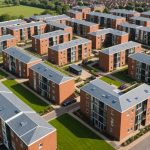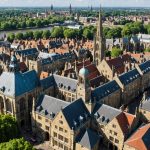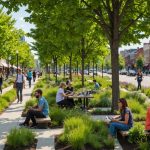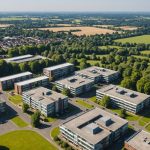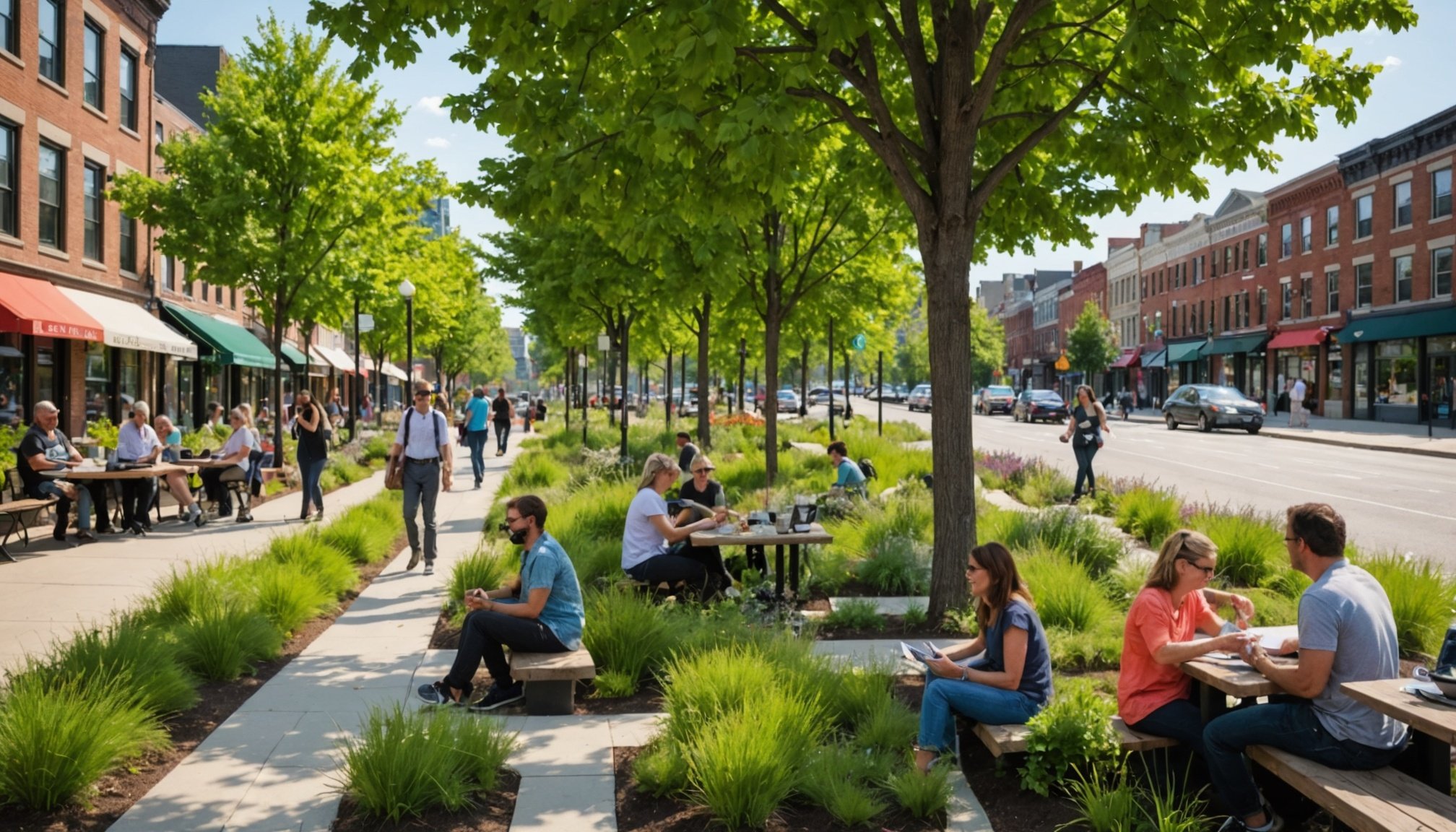Importance of Public Green Spaces
Public green spaces are invaluable assets in urban settings, providing much-needed balance amid the concrete landscapes. They serve as communal oases, facilitating social interactions and fostering community cohesion. When individuals gather in public parks or gardens, they are more likely to engage with their neighbours, strengthening social ties and creating a sense of belonging.
The health benefits associated with access to nature are significant. Green spaces support mental well-being by offering a respite from the urban grind, reducing stress and anxiety. Time spent in nature has been linked to improved mood and cognitive function. Moreover, these spaces encourage physical activity. Whether it’s a casual walk, a vigorous jog, or a group workout, urban greening projects can enhance community health by promoting a more active lifestyle.
Also read : Enhancing Rural Welsh Real Estate: The Benefits of Geothermal Heating for Homeowners
Environmental benefits also play a crucial role. Urban greening contributes to urban biodiversity, providing habitats for various species. This ecological boost helps sustain healthy systems and improves air quality. In essence, public green spaces are not just aesthetic enhancements; they are vital to creating livable, resilient cities that prioritize the well-being of their communities and environments.
Expert Insights and Opinions
Gathering insights from urban planning professionals and community leaders provides invaluable perspectives on implementing effective greening strategies. Experts highlight the importance of incorporating public green spaces in urban planning to balance development with nature. This approach not only enhances urban aesthetics but also contributes to the overall well-being of city dwellers.
Also to read : Maximizing Community Impact: Innovative Approaches for Property Developers in UK Housing Projects
Community leaders involved in successful projects often emphasize the role of community engagement. They note that involving residents in the creation and maintenance of green spaces fosters a sense of ownership and responsibility. This involvement can lead to more sustainable and well-maintained spaces, as the community actively participates in their upkeep.
Current trends in urban green space development show a shift towards multifunctional spaces that serve various community needs. By integrating play areas, walking paths, and gardens, cities can cater to diverse groups, promoting broader usage and interaction across different demographics. Such inclusive strategies are vital for ensuring that public green spaces remain relevant and beneficial to all community members.
Expert analysis and insights offer crucial guidance, ensuring urban greening projects achieve their intended goals of enhancing community health, fostering social interactions, and supporting urban biodiversity.
Successful Urban Greening Projects
Urban greening projects breathe new life into cities, transforming underutilized areas into vibrant, green spaces. They offer a creative solution to urban challenges by integrating nature into urban settings. These projects often serve as examples of how effective planning and execution can result in tangible benefits for both the environment and community well-being.
Iconic Examples of Revitalized Urban Spaces
Revitalization projects, such as high-profile park conversions and community gardens, have demonstrated notable success. Take, for instance, the High Line in New York City, which transformed an abandoned railway into a thriving public park. These projects are not only visually striking but also serve a dual purpose: enhancing aesthetics while providing communal, green spaces.
Impact on Local Communities
The impact on local communities goes beyond aesthetics. Social interactions flourish in these settings, as people gather to enjoy the natural environment. Such spaces become community hubs, facilitating engagement and cohesion while also encouraging an active lifestyle.
Lessons Learned from Project Implementation
Key lessons from these successful implementations underscore the importance of community engagement from the outset. By involving local residents in the planning and maintenance phases, projects ensure a sense of ownership and sustainability, ultimately leading to well-kept and cherished urban green spaces.
Benefits of Green Spaces on Community Health
Public green spaces are pivotal in nurturing both mental and physical well-being. Access to nature in urban areas can lead to notable improvements in mental health by reducing stress and anxiety levels. These serene environments provide a much-needed escape from the urban hustle, enabling city dwellers to unwind and rejuvenate. Research has consistently shown that individuals who spend time in green spaces report enhanced mood and cognitive function, highlighting the profound impact these environments have on mental well-being.
Moreover, public green spaces encourage increased physical activity, contributing significantly to overall community health. Whether engaging in leisurely walks or vigorous exercise routines, these places promote diverse forms of physical activities. As such, they are essential in fostering a healthy and active lifestyle among urban populations.
The role of urban biodiversity within green spaces cannot be overlooked, as it supports sustaining healthy ecosystems. By accommodating various species, these areas contribute to ecological balance and improve air quality, thus benefiting human health indirectly. Through the lens of public health, green spaces serve as indispensable components of urban design, directly and indirectly enhancing the well-being of city inhabitants.
Strategies for Implementing Green Spaces
An effective approach to implementing urban green spaces involves a combination of strategic planning, community participation, and sustainable practices. Central to this process is prioritising community involvement. Engaging local residents, businesses, and stakeholders ensures that the design and function of green spaces meet the unique needs of the community. By fostering a sense of ownership, this involvement often leads to more vibrant and sustainable urban greening projects.
Engaging Community Stakeholders
Community involvement is not just beneficial but essential. Successful projects often establish forums or committees to integrate community input from the start. This inclusion encourages creative solutions that resonate with local culture and requirements, enhancing both usage and longevity.
Planning and Design Considerations
Effective urban planning and design focus on flexible spaces that accommodate diverse activities and demographics. Incorporating paths, seating, and sports areas ensures these spaces are multifunctional, inviting a wide array of users.
Maintenance and Sustainable Practices
Long-term success relies on sustainable maintenance practices. Strategies include selecting native plant species for reduced upkeep and establishing maintenance teams that include local community members. This approach not only preserves the environment but also strengthens community health through continued engagement and activity.
Visualizing the Impact of Green Spaces
Visual aids serve as powerful tools in highlighting the transformation brought about by urban greening. Before-and-after images effectively showcase the tangible benefits of converting barren urban areas into lush, thriving spaces, offering a visual testament to their impact on community health and the environment.
Infographics provide an accessible way to convey complex data related to these transformations, illustrating improvements in air quality, increases in community engagement, and reductions in temperature due to enhanced greenery. Such visuals not only inform but also inspire citizens and policymakers by depicting the holistic benefits of these projects.
Imagery plays a crucial role in fostering community involvement and raising awareness about the importance of public green spaces. By presenting clear and compelling examples of urban transformations, visuals encourage greater participation from local residents and stakeholders in both the planning and usage of these spaces. They act as motivational tools, driving home the long-term benefits of urban greening initiatives for both the environment and community cohesion.
Overall, integrating visual aids in communications about urban greening projects helps cement the understanding and enthusiasm needed to support such endeavours, ensuring continued investment in the creation and preservation of public green spaces.


